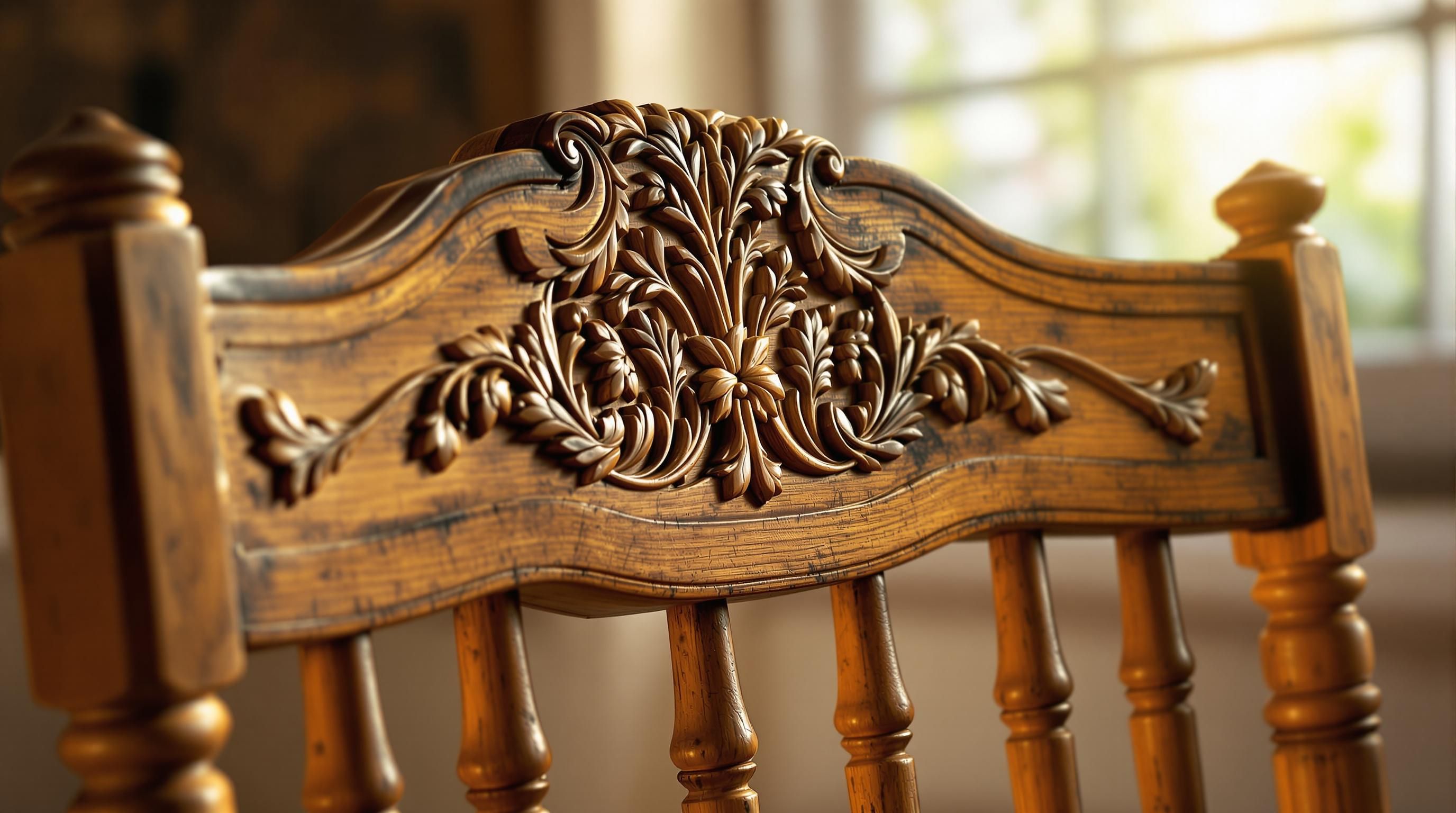Introduction to Antique Rocking Chairs
A true antique rocking chair isn’t just an old piece of furniture—it’s a cultural artifact that tells stories of domestic life across centuries. Whether you’ve inherited a family heirloom, discovered a potential treasure at an estate sale, or are considering investing in antique furniture, understanding what determines a rocking chair’s value is essential.
In this comprehensive guide, we’ll explore the fascinating world of antique rocking chairs, from their historical development to identification techniques, valuation factors, and current market trends. By the end, you’ll have the knowledge to better assess the worth of these timeless pieces.
Antique Rocking Chair Market Snapshot
The History of Rocking Chairs
Evolution of Rocking Chairs
- 1725
Early Beginnings
The rocking chair concept originated when someone attached skates to the bottom of an English Yorkshire Windsor chair, creating the first rudimentary rocking motion. - 1787
Official Recognition
The term "rocking chair" was officially entered into the dictionary, acknowledging this furniture style as a distinct category. - 1820
Shaker Innovation
The Shaker rocking chair was invented in New York, introducing minimalist design principles that emphasized function, simplicity, and quality craftsmanship. - 1825
Boston Rocker Emerges
The Boston Rocking Chair style appeared, featuring a decorative seat and curved back, becoming one of America's most iconic designs. - 1860-1900
Victorian Era
Victorian rocking chairs featured elaborate carvings, plush upholstery, and various woods like walnut, mahogany, and rosewood. Platform rockers with spring mechanisms also gained popularity. - Early 1900s
Mission & Arts and Crafts
These movements brought simpler, sturdier designs with straight lines, exposed joinery, and quarter-sawn oak in response to Victorian ornamentation.
The historical evolution of rocking chairs helps explain the vast diversity in styles available in today’s antique market. According to the Troutman Chair Company, understanding these historical periods is crucial for proper identification and valuation of antique examples.
Identifying Antique Rocking Chair Styles
Common Antique Rocking Chair Styles
Windsor Rockers: Dating back to the 18th century, Windsor rockers feature spindle backs and saddle seats, typically made of multiple wood types. They often have a continuous bow back and can include writing arms.
Boston Rockers: Popular in the early 19th century, these chairs have decorative stenciling on the seat and back, with a curved top rail and turned spindles. The seat often curves down at the front.
Shaker Rockers: Known for their minimalist design, Shaker rocking chairs feature simple, functional forms with woven tape seats, ladder backs, and fine craftsmanship, usually in maple or cherry.
Victorian Rockers: Dating from 1837-1901, Victorian rocking chairs are characterized by ornate carvings, plush upholstery, and elaborate detailing. They often include floral motifs, carved crests, and cabriole legs.
Platform Rockers: Emerging in the late 19th century, these chairs rock on a spring-loaded base rather than curved runners, often with upholstered seats and backs for added comfort.
Bentwood Rockers: Popularized by Michael Thonet in the mid-19th century, these feature gracefully curved elements created by steaming and bending wood, typically beech, into elegant forms.
According to the LoveToKnow antiques guide, additional styles include mission rockers, Lincoln rockers, and nursing rockers, each with distinctive features that help determine their age and origin.
Key Value Factors for Antique Rocking Chairs

Age and Authenticity
Generally, older authentic rocking chairs command higher prices, especially those from the 18th and early 19th centuries. According to experts at Mearto, chairs dating before 1850 are particularly valuable due to their rarity and historical significance. However, age must be verified through appropriate construction techniques, materials, and patina.
Maker and Provenance
Chairs from renowned furniture makers or with documented historical provenance can be substantially more valuable. Look for maker’s marks, labels, or signatures, which are often found underneath the seat or on the rockers. Some prestigious makers include:
- Hitchcock Chair Company
- Thonet
- Stickley
- R.J. Horner
- George Hunzinger
According to discussions on AVForums, a chair with documented history or from a famous maker can command prices 3-5 times higher than similar unmarked examples.
Condition
Condition dramatically impacts value. Factors include:
- Original finish vs. refinishing
- Structural integrity (loose joints, repairs)
- Completeness (all original parts present)
- Wood condition (water damage, insect damage, cracks)
- Original vs. replacement upholstery
Antique Rocking Chair Condition Assessment
Use this checklist to evaluate your rocking chair's condition
- Original finish intact with natural patina
- No major repairs or replacements of key components
- Joints are tight and secure
- Free from wood rot, significant cracks, or insect damage
- Original hardware (if applicable)
- Retains maker's marks or labels
- If upholstered, fabric is in good condition or appropriately restored
- Rockers show even wear consistent with age
- Free from inappropriate modern fasteners or materials
Materials and Craftsmanship
The materials used in construction significantly affect value:
- High-quality hardwoods (walnut, mahogany, cherry) typically command higher prices than pine or less desirable woods
- Hand-cut joinery vs. machine-made connections
- Hand carving vs. machine carving
- Quality of upholstery materials (if present)
Rarity and Desirability
Uncommon styles, limited productions, or chairs with unique features often have higher values. Market demand also shifts based on interior design trends and collector interests.
Current Market Values for Antique Rocking Chairs

Antique Rocking Chair Price Ranges
Average market values based on style, age, and condition (2023-2024)
</tbody>
</table>
According to The Rocking Chair Company, a Plail Brothers oak rocking chair with mortise and tenon joints and pegged construction typically brings around $354 in today’s market. Meanwhile, experts on JustAnswer suggest that many common vintage rocking chairs from the early 20th century fall into the $75-$125 range when in average condition.
For current examples of antique rocking chairs on the market, you can browse listings on platforms like eBay’s Antique Rocking Chairs section, Chairish, and 1stDibs, where prices range from a few hundred to several thousand dollars depending on rarity, condition, and provenance.
How to Identify Valuable Antique Rocking Chairs
Construction Techniques
Examine how the chair is assembled:
- Joinery: Hand-cut dovetail or mortise and tenon joints indicate older, higher-quality construction compared to screws or nails
- Dowels: Wooden dowels rather than metal fasteners suggest traditional craftsmanship
- Seat Construction: Rush, cane, or splint seats should show appropriate age-consistent wear
- Tool Marks: Irregular saw marks or plane marks suggest hand tools rather than machine production
Wood and Materials
The materials used can provide important clues:
- Wood Type: Identify the primary and secondary woods used (primary wood typically on visible surfaces, secondary woods underneath or inside)
- Patina: Natural aging of wood creates a patina that’s difficult to fake
- Growth Rings: Older furniture often used old-growth timber with tighter growth rings
- Multiple Woods: Many antique chairs used different woods for different parts based on structural needs
Wear Patterns
Authentic wear provides evidence of age and use:
- Rocker Wear: The curved runners should show consistent wear patterns in keeping with the chair’s age
- Arm Wear: Natural smoothing and patina on arms where hands rested
- Seat Wear: Depression and wear in the seat consistent with years of use
- Floor Rub Marks: Where the rockers contacted the floor
According to Reddit discussions, even subtle details like the type of finish, oxidation patterns, and hardware style can help distinguish valuable antiques from reproductions.
Where to Sell Antique Rocking Chairs
Online Marketplaces
- eBay: Offers wide reach but requires careful shipping considerations
- Chairish: Specializes in vintage and antique furniture with a curated approach
- 1stDibs: Focuses on high-end antiques with professional dealers
- Facebook Marketplace: Good for local sales without shipping concerns
- Etsy: Works well for unique, higher-quality antiques with character
Local Options
- Antique Dealers: May purchase outright or sell on consignment
- Auction Houses: Good for rare or high-value pieces with provenance
- Estate Sales Companies: Can include your piece in a larger sale
- Consignment Shops: Sell on your behalf for a percentage of the sale
Maximizing Your Sale Value
- Documentation: Gather any provenance, history, or maker information
- Condition: Consider professional cleaning or appropriate repairs
- Photography: Take clear, well-lit photos from multiple angles
- Description: Be detailed about age, materials, condition, and any known history
- Pricing Strategy: Research comparable sales to set a realistic price
Getting a Professional Appraisal
Types of Appraisals
- Verbal Approximation: Quick estimate, often free or low-cost at antique shops
- Written Appraisal: Formal document with detailed description and valuation
- Insurance Appraisal: Specifically for insurance coverage, typically uses replacement value
- Estate Appraisal: For inheritance or estate settlement purposes
- Fair Market Value Appraisal: For donation or sale purposes
Finding a Qualified Appraiser
Look for appraisers with:
- Membership in professional organizations (American Society of Appraisers, International Society of Appraisers)
- Specialization in antique furniture or American antiques
- No conflict of interest (not trying to buy the item themselves)
- Transparent fee structure (typically hourly rather than percentage-based)
According to Mearto’s appraisal guidelines, online appraisal services can provide preliminary valuations, but for significant pieces, an in-person examination by a qualified expert is recommended.
Common Questions About Antique Rocking Chair Values
How do I know if my rocking chair is valuable?
To determine if your rocking chair is valuable, examine these key indicators:
- Age: Generally, chairs made before 1900 have greater potential value
- Maker’s Marks: Look for signatures, labels, or stamps (often found underneath)
- Construction: Hand-cut joinery and wooden pegs suggest higher quality craftsmanship
- Style: Identify the specific style (Windsor, Boston, Shaker, etc.) through research
- Condition: Original finish and components typically increase value
- Materials: Higher-quality hardwoods like walnut or mahogany tend to be more valuable
The style can be linked to the period of manufacture, which helps determine age. According to Mearto’s experts, specific markings or signatures significantly impact value determination, and these markings are often found underneath the seat of the rocker.
What year was the rocking chair invented?
The rocking chair concept began in 1725 when skates were attached to the bottom of an English Yorkshire Windsor chair. The term "rocking chair" was first recorded in the dictionary in 1787.Key developments include:
- 1725: First rudimentary rocking chair concept
- 1787: Term "rocking chair" officially entered the dictionary
- 1820: Shaker rocking chair invented in New York
- 1825: Boston Rocking Chair style emerged
These early dates help establish the historical timeline for antique identification. The oldest American rocking chairs date to the late 18th century, with earlier examples being extremely rare and valuable.
How much are antique rocking chairs from the 1800s worth?
Antique rocking chairs from the 1800s can vary dramatically in value:
- Early 19th century (1800-1830): $500-$3,000+, depending on style and condition
- Mid-19th century (1830-1870): $350-$1,500, with Victorian examples often in this range
- Late 19th century (1870-1900): $200-$1,200, including platform rockers and bentwood styles
Factors that significantly affect the price include:
- Original finish vs. refinished
- Completeness (all original parts)
- Documented provenance
- Maker’s marks or labels
- Rare or unusual features
According to data from eBay and auction sites, exceptional examples from well-known makers can exceed these ranges.
How do I find the value of my old chair?
To find the value of your old rocking chair:
- Document the Chair: Take detailed photos from all angles
- Research the Style: Identify the specific style through reference books or online resources
- Check for Markings: Look under the seat and on structural elements for maker’s marks
- Assess Condition: Note any repairs, damage, or alterations
- Research Comparable Sales: Look at recent auction results and dealer listings
- Consult Experts: Consider taking it to an antique dealer, furniture specialist, or appraiser
- Online Appraisal: Services like Mearto or JustAnswer can provide preliminary valuations
Remember that rarity significantly affects value. As noted by antiques experts, fewer pieces mean higher demand, and knowing your chair’s unique characteristics will give you a better idea of its worth.
Are antique rocking chairs from the 1900s worth anything?
Antique rocking chairs from the early 1900s (1900-1930) do have value, though typically less than their 19th-century counterparts:
- Arts & Crafts/Mission style (1900-1920): $300-$2,000, with higher values for pieces by known makers like Stickley
- Early 20th century nursing rockers: $150-$600
- Platform rockers from this era: $150-$500
- Wicker rockers: $200-$800, depending on condition
According to antique dealers on JustAnswer, common early 20th century rocking chairs in average condition typically sell for $75-$125. However, exceptional examples with documented provenance or from prominent designers can command much higher prices.
While not as valuable as earlier pieces, these chairs are increasingly collected as they pass the 100-year threshold that technically defines antiques.
Care and Preservation of Antique Rocking Chairs
Cleaning and Maintenance
- Regular Dusting: Use a soft, lint-free cloth to gently remove dust
- Cleaning Wood: Wipe with a slightly damp cloth, then dry immediately
- Avoid Modern Polishes: Many contain silicones or other chemicals that can damage antique finishes
- Traditional Waxing: For finished wood, use high-quality paste wax 1-2 times per year
- Upholstery Care: Vacuum upholstered seats with a soft brush attachment
Environmental Considerations
- Humidity Control: Maintain 40-60% relative humidity to prevent wood from drying out or absorbing too much moisture
- Temperature Stability: Avoid extreme temperature fluctuations
- Sunlight Exposure: Keep away from direct sunlight to prevent finish fading and wood damage
- Proper Support: Ensure floors are level to prevent stress on joints
Restoration Considerations
- Minimal Intervention: Follow the principle of doing the least possible to preserve authenticity
- Original Finish: Whenever possible, preserve rather than replace the original finish
- Appropriate Materials: Use period-appropriate materials for any necessary repairs
- Documentation: Keep records of any restoration work done
Professional Help
For significant repairs or restoration, consult with professionals specializing in antique furniture. Their expertise can help preserve value while addressing structural issues.
External Resources for Antique Rocking Chair Research
The Rocking Chair Company - Antique Guide
Comprehensive guide to antique rocking chair styles, values, and historical significance, including detailed information on the most sought-after models.
LoveToKnow - Identifying Antique Rocking Chairs
Detailed identification guide covering styles, dates, and values of antique rocking chairs, with visual examples and expert insights.
Mearto - Antique Rocking Chair Appraisals
Professional appraisal resource for antique rocking chairs, offering valuation services and educational content about value factors.
Troutman Chair Co. - History of Rocking Chairs
Historical overview of rocking chair development from early origins to modern designs, providing context for antique identification.
eBay - Antique Rocking Chair Marketplace
Live marketplace showing current asking prices and recently sold examples of antique rocking chairs across various styles and conditions.
1stDibs - Premium Antique Rocking Chairs
Curated selection of high-end antique rocking chairs from professional dealers, showcasing investment-quality examples with detailed provenance.
Chairish - Vintage & Antique Rocking Chair Collection
Design-focused marketplace featuring vetted antique and vintage rocking chairs with detailed descriptions and authenticated provenance.
Conclusion
Antique rocking chairs represent both functional furniture and tangible connections to our past. Their value extends beyond monetary considerations to include historical significance, craftsmanship appreciation, and personal heritage.
When assessing the value of an antique rocking chair, consider all the factors we’ve discussed: age, style, maker, condition, materials, and current market conditions. For truly valuable or rare examples, professional appraisal is always recommended.
Whether you’re a collector, inheritor, or simply curious about that old rocker in the attic, understanding what determines value can help you make informed decisions about care, restoration, and potential sale. With proper identification, care, and appreciation, these cherished artifacts can continue to provide both comfort and connection to our shared history for generations to come.
Get a Professional Appraisal
Unsure about your item’s value? Our certified experts provide fast, written appraisals you can trust.
- Expert report with photos and comps
- Fast turnaround
- Fixed, upfront pricing
No obligation. Secure upload.
| Category | Price | Notes |
|---|---|---|
| Early Windsor (1750-1830) | $800-$3,000+ | Highest for original finish, complete examples |
| Boston Rockers (1820-1850) | $400-$1,200 | Premium for original stenciling and paint |
| Shaker Style (1820-1860) | $600-$2,500 | Authentic examples with provenance command highest prices |
| Victorian Rockers (1837-1901) | $350-$1,500 | Elaborate carved examples in excellent condition bring premium |
| Platform Rockers (1870-1920) | $200-$800 | Working mechanism and original upholstery increase value |
| Bentwood Rockers (1860-1910) | $300-$1,200 | Authentic Thonet examples can exceed $2,000 |
| Mission/Arts & Crafts (1900-1930) | $400-$2,000 | Stickley and other named makers command highest prices |
| Plail Brothers Oak Rocker | $350-$500 | With mortise and tenon joints, pegged construction |




